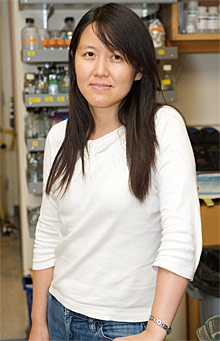Two young UC Berkeley faculty members receive MacArthur 'genius' award
| 22 September 2009
BERKELEY — A 35-year-old molecular biologist and a 37-year-old computer scientist from the University of California, Berkeley, are among 24 new MacArthur "genius" Fellows announced Tuesday, Sept. 22, by The John D. and Catherine T. MacArthur Foundation.
Lin He, an assistant professor of molecular and cell biology, has helped demonstrate the role of tiny RNA, called microRNA, in the development of cancer. Maneesh Agrawala is an associate professor in the Department of Electrical Engineering and Computer Sciences who is automating the process by which complex information is presented visually.
"This was a big surprise," said He, who was informed a week ago. "I'm really grateful to whoever nominated me; it's a great honor. This kind of fellowship is tremendously helpful for a young person like me who has high-risk ideas, but not the money to do the research. This will allow us to be very exploratory without having to worry about financial resources."
Agrawala got the call notifying him of the award while working at home. "I was just really shocked; I was speechless," he said. "And then I started thinking about all the colleagues and mentors I've worked with in the past 15 years. The work I've done in that time has been very collaborative. The MacArthur award recognizes those collaborations."
Each recipient will receive $500,000 in "no strings attached" support over the next five years, offering "unprecedented freedom and opportunity to reflect, create and explore," according to the foundation's press release.
 Lin He (Photos courtesy the MacArthur Foundation) |
Lin He's research involves a class of small ribonucleic acid, or RNA, that are not transcribed into protein like messenger RNA. Instead, these microRNAs or miRNAs bind to messenger RNA to regulate the amount of protein produced. This entirely new level of dosage regulation in mammals was not realized until 2000, even though miRNAs were first discovered in 1993. Now, miRNAs have been shown to be involved in many aspects of development and diseases, He said.
"MicroRNAs are a mechanism to fine-tune gene expression simultaneously in many different pathways, achieving a homeostasis very much needed for many biological processes," He said. "In the case of cancer, where some microRNAs behave abnormally, detrimental effects will occur due to the loss of proper gene regulation by microRNAs."
He has shown that miRNAs play a role in a broad range of cancers, in particular those such as lung cancer that involve mutations in the p53 tumor suppressor gene. She is also investigating the role of miRNA in the development of B cell lymphomas.
"In an area that has generated intense effort among many leading researchers, Lin He has established early in her career the capacity to make significant advances with direct implications for the development of future cancer treatment strategies," the MacArthur Foundation noted.
He received a B.S. in 1997 from Tsinghua University in Beijing, China, and a Ph.D. in 2003 from Stanford University. She was a postdoctoral fellow at Cold Spring Harbor Laboratory in New York until joining the UC Berkeley faculty in 2008.
 Maneesh Agrawala |
"People often create images, illustrations and photographs to convey an idea or information to other people," said Agrawala. "In this process, they ideally highlight things that are important and de-emphasize the things that are not. In my lab, we are developing algorithms that automatically focus on the key information people need to understand the message being conveyed."
As an example, the MacArthur Foundation highlighted the automated map rendering system Agrawala developed while he was a graduate student at Stanford University. The program, called LineDrive, generates a simple, schematic route map that emphasizes the sequence of turns to take. The system also eliminates the extraneous details – including city names, parks and roads that are far from the route taken – that are typically given in route maps from most computer mapping systems.
Agrawala has also developed algorithms to automatically generate step-by-step instructions found in tutorials for software and instruction manuals for assembling objects as simple as a table or as complex as an aircraft engine.
"It may seem obvious, but our system generates only one diagram showing a single major action per step so that users can more easily follow what they have to do," said Agrawala. "In contrast, many instruction manuals present all parts and assembly actions in a single diagram, which makes them very hard to follow."
To make photo manipulation easier, Agrawala is creating algorithms that would automatically correct the distortion in wide angle photographs. He also is developing tools to enhance visual storytelling, such as an innovative video puppetry project. The tool helps people easily create animation without learning complex software by using an overhead camera to capture the movement of characters drawn by hand and then cut from paper.
Prior to joining UC Berkeley's faculty, Agrawala worked at Microsoft Research for three years. He received a bachelor's degree in mathematics and a Ph.D. in computer science from Stanford University.
For more information, link to the MacArthur Foundation Web site.

